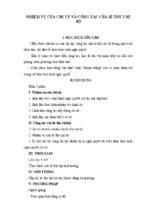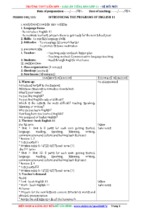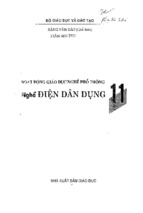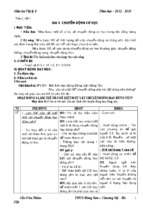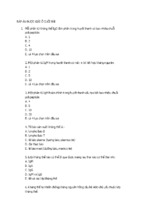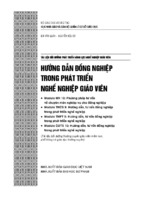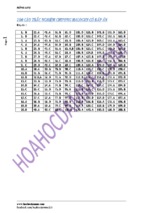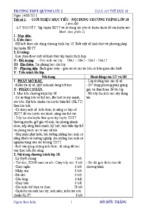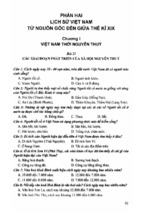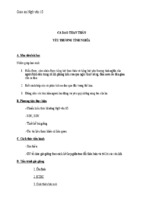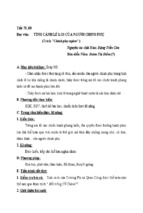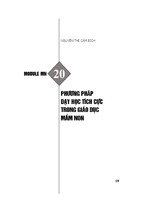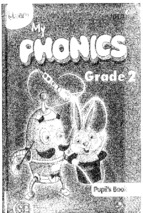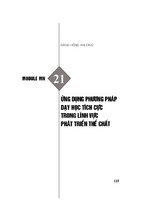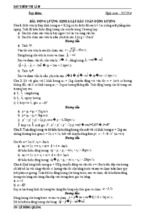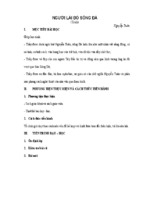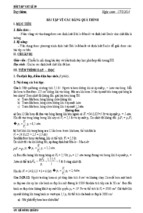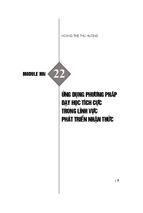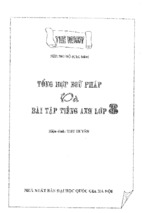giáo án thí điểm tiếng anh 10 4 cột
Period 42: Correction test – Test 2-45’
A. Objectives:
- In this lesson, teacher evaluates Ss’ knowledge and offers a comprehensive review of Ss’ written
tests. Teacher has an overview of what they can do and what they can’t do.
- By the end of the lesson, students will be able to:
+ Be aware of the mistakes and know how to correct them.
B. Preparations:
- Teacher: Students’ tests.
- Students: Grammar and vocabulary.
C. Methods: - The whole lesson: Integrated, mainly communicative.
D. Procedures:
I. Answer keys:
Part A: Listening ( 0.3 point/ 1 correct answer)
Question I:
1. F
2. F
3. T
Question II:
1. A
2.C
3. D
4. F
5. F
Part B: Grammar, phonetics and vocabulary ( 0.2 point/ 1 correct answer)
Question I:
1. D
2. B
3. A
Question II:
1. A
2. B
3. A
Question III: 1. A
2. D
3. B
4. B
5. B
6. B
7. D
8. C
Part C: Reading ( 0.3 point/ 1 correct answer)
Question I:
1. A
2. C
3. C
4. A
Question II:
1. A
2. C
3. A
4. A
Part D: Writing
Question I: ( 0.25 point/ 1 correct answer)
1. C
2. A
Question II: ( 0.5 point/ 1 correct answer)
1. This machine isn’t used very often.
1
2. I am not often invited to their parties.
3. Wine is included in the menu.
II. General comments:
.......................................................................................................................................................
.......................................................................................................................................................
.......................................................................................................................................................
...............................................................................................
III. Common mistakes:
.......................................................................................................................................................
.......................................................................................................................................................
.......................................................................................................................................................
...............................................................................................
IV. Experiences:
.......................................................................................................................................................
.......................................................................................................................................................
....................................................................
UNIT 5. Inventions
I. AIMS
1. Knowledge: By the end of this lesson Ss will be able to:
- Use words and phrases related to inventions.
2
- Pronounce stress patterns in compound nouns and noun groups correctly in isolation and in context.
- Use present perfect, gerunds and infinitives correctly
2. Skills
By the end of this lesson Ss will be able to:
- Read for main ideas and specific information about natural world as inspiration for inventions and
match the words with their definition and answer the questions
- Exchange opinion about inventions, their uses and their benefits.
- Listen for specific information from an interview.
- Write about the benefits of an invention.
II. Methods
- Learning activity - centered
III.TEACHING AIDS
- A cassette player and the tape, pictures in the textbook and other material ( if available)
IV. Anticipated problem
Ss may not know lexical items related to topic inventions and natural world as inspiration for inventions that
prevents them from acquiring the reading content.
V. Procedure
Lesson 1: Getting started
Lesson 2: Language: Vocabulary+ Pronunciation
Lesson 3: Language: Grammar
Lesson 4: Reading
Lesson 5: Speaking
Lesson 6: Listening
Lesson 7: Writing
Lesson 8: Communication and culture
Lesson 9: Looking back and project
UNIT 5: INVENTIONS
PERIOD 43. GETTING STARTED
Date of making: ……………………..
Date of teaching: ……………………..
1. Objective:
By the end of this lesson Ss will be able to:
- Use some lexical items related to the topic inventions.
+ Make simple dialogues using the given expressions.
+ Ask and answer simple questions about modern devices.
. Teaching aids
3
- A cassette player and the tape, pictures in the textbook and other material ( if available)
3. Procedure.
Steps + time
Learning activities
Warm up (2 look at the picture and introduce
minutes)
Phong and his father and answer the
Language focus
Mode
- Words and phrases - Whole class
related to volunteers
question:
What are Phong and his father talking
about?
They are talking about modern
devices like smart phone, laptop…..
New lesson
(10 minutes)
Activity 1
Task 1: Listen and read
- Listen and read the conversation.
- Ss, in pairs, practise reading the
dialogue aloud.
- Words and phrases
related to inventions
- Whole class
- Pronunciation, linking
sound, tune ….
- Pronunciation, linking
sound, tune ….
- Pairs
- Pairs
- Give comment on Ss’ pronunciation.
4
Activity 2
-Task 2: Answer the questions
- answering questions
- Individual
- Pairs
- Whole class
- Pronunciation, stress
- Whole class
- Individual
then
pair
work
- Whole class
- ask and answer.
- understand the questions and key
words in Activity 2
- ask and answer questions about the
conversation.
- Check the answers and provide the
correct ones if necessary.
(15 minutes)
- Suggested answers:
1. He promised to reward Phong if he
passed the English test.
2. Because his old mobile phone is
still good.
3. Computers have changed our lives
in many ways: faster communication,
free entertainment and convenient
shopping.
4. He will use his laptop for listening
to music, playing games, chatting
with his friends, researching topics on
the Web and typing his assignment.
Task 3: Matching
- Have Ss read the dialogue again and
underline the words in the table.
(10 minutes)
- guess the meaning of these words.
- match the words with the
definitions.
- Check Ss’ answers.
- read these words.
- Part of speech of the
words related to topic - Individual
inventions
then
pair
work
- Whole class
5
Consolidation - Consolidate the main points.
and
- Learn by heart new words
homework
- Prepare for the next lesson
(8 minutes)
- Whole class
Comments:
…………………………………………………………………………………………………………
…………………………………………………………………………………………………………
…………………………………………………………………………………………………
PERIOD 44. LANGUAGE
Vocabulary + Pronunciation
Date of making: ……………………..
Date of teaching: ……………………..
1. Objective:
By the end of this lesson Ss will be able to:
+ Pronounce compound nouns and noun groups in isolation and in context.
+ Use some lexical items related to the topic inventions.
2. Teaching aids
- A cassette player and the tape, pictures in the textbook and other material ( if available)
3. Procedure.
Step + time
Learning activities
Warm up (5 - Look some pictures and asks Ss in
minutes)
two teams to write a compound noun
Language focus
Mode
Compound
nouns - Whole class
related to inventions
- group work
to describe each picture.
* Answer:
School-boy,
boy
–school,
blackboard, laptop, headphone.
6
7
New lesson
(10 minutes)
Vocabulary
A. Vocabulary:
Task 1: Matching
related to inventions
- Individual
- Pairs
- Whole class
- Word stress
- Pairs
- - compound nouns
- give the meaning of the compound
nouns and their parts.
- write on the board and give
comment.
(10 minutes)
- realize that most of compound
nouns have the meanings as a
combination of their parts, however,
some words have different meaning
like “ laptop”
- Check answer as a class.
* Key: 1. video game: a game in
which players control and move
images on a screen
- video: film or image
(10 minutes)
- game: something you play for fun
2. smartphone: a mobile phone that
has some functions of a computer
- smart: intelligent, computercontrolled
- phone: a telephone
(10 minutes)
3. laptop: a portable, small computer
that can work with a battery
- lap: top part of your leg
- top: upper surface
4. e-book: a book that is displayed on
a computer screen or an electronic
device
- electronic: using microchips to
control a small electric current
- book: a written work
8
Activity 2
- compound nouns
Task 2:
related to inventions
- match the first part of words with
the second ones.
Pairs
- Whole class
- Check words and meaning of these
compound nouns.
- Check answers and give
explanation.
- Exchange the answers
- look up the words in the glossary, if
necessary.
* Key: 1. pencil case
blackboard
2.
3. washing machine
headphones
processor
4.
5. food
Pronunciation
Activity 1
- Task 1: Listen and repeat
- repeat chorally and individually.
- stress words
compound nouns
with - Whole class
- Pairs
- Individual
- Focus on the stress patterns of
compound nouns ( main stress is
usually on the first part) and noun
groups ( main stress is on the
second part).
- repeat each word chorally.
- Give the meaning of the words if
necessary. distinguish compound
nouns and noun groups.
- work in pairs and take turns reading
the words.
9
Activity 2
- Task 2: Listen and tick
- stress
nouns,
in
compound - Pairs
- tick (v) before the stressed syllable
in each word.
- individual
and
whole
class.
- take turns reading the words.
- read the words in front of the class.
Correct mistakes if any.
* Key: 1. b
b 5. a
Consolidation
and
home work
(3 minutes)
2. a
3. a
4.
- Read aloud the words in front of the
class
- Consolidate the main points
- Learn by heart new words, practice
consonants clusters in the lesson
- Prepare for the next lesson
Whole class
Comments:
…………………………………………………………………………………………………………
…………………………………………………………………………………………………………
…………………………………………………………………………………………………
PERIOD 45. LANGUAGE (continue)
(Grammar)
Date of making: ……………………..
Date of teaching: ……………………..
1. Objective:
By the end of this lesson Ss will be able to:
+ Understand and use the present perfect tense to describe an event or action and the gerunds and
infinitives to talk about the uses or purposes of something.
2. Teaching aids
- A cassette player and the tape, pictures in the textbook and other material ( if available)
3. Procedure.
Step + time
Warm up
(2 minutes)
New lesson
(10 minutes)
Learning activities
- Answer teacher’s questions
present perfect
Language focus
with - tense and aspects
Mode
- Whole class
a. Gerunds and infinitives
Activity 1:
- Explain that: V- ing is used after
- The usage of to v and - Individual
ving
- Pair work
10
for and To inf. is used to describe
purpose of something.
- Whole class
- Individual
- do Exercise 1 individually in 5
minutes.
- check the answers
- Key: 1. getting, sending 2. to
create, to contract
4. to play
chopping, mixing
(25 minutes)
3. to read
5.
6. to store
The present perfect tense
Activity 1:
- Draw the timelines on the board
and write a word from the box above
each line.
- - The usage of “past - Individual
simple
and
past
continuous
- Pair work
- Irregular verbs
- Whole class
- label the timelines with the words
from the box.
- explain more about the present
prefect.
Activity 2:
- match the beginning with suitable
ending then put the verb in the
present perfect or the present simple.
- Check and comment.
1.c ( has broken)
2. d (looks - has lost)
3. e (do you know, have got )
4. a ( have asked)
5. c ( left - have disappeared)
Activity 3:
11
- Have Ss do this
individually in 5 minutes.
exercise
- Check the answers with the whole
class
- Provide the answer and the
explanations.
* Answer: 1. seems
affected 3. were
2. have
4. have encouraged
5. has aided
6. have killed
7. prefer
Consolidation - Consolidate the main points
and
home - Prepare for the next period
work
(8 minutes)
Comments:
…………………………………………………………………………………………………………
…………………………………………………………………………………………………………
…………………………………………………………………………………………………
PERIOD 46. READING
Date of making: ……………………..
Date of teaching: ……………………..
1. Objective: By the end of the lessons, students will be able to:
+ Read for general ideas and for specific information about natural world as inspiration for inventions
and match the words with their definition and answer the questions.
+ Know about some inventions inspired by natur
2. Teaching aids
- A cassette player and the tape, pictures in the textbook and other material ( if available)
3. Procedure.
Step + time
Warm -up
(5 minutes)
Learning activities
Activity 1
Wonderful nature
Activity 1:
Language focus
Mode
- Words and phrases related - Groups
to volunteer work
- Individual and
12
Have Ss look at the pictures in the
textbook and tell:
whole class
1. What can the animals or leaves do
that people can’t?
2. What objects have people
invented to make up for what they
can’t do?
- Assist Ss with useful words to
express their ideas.
- Ss look at the pictures and tell the
abilities of the creatures and leaves
mentioned in the textbook.
* Suggested answer:
Picture a: a bird can fly
Picture b: a dolphin can stay under
water for a long time.
Picture c: a lotus leave doesn’t get
wet.
People have invented an
aeroplane, a ship or submarine, and a
waterproof raincoat to make up for
what they can’t do.
13
New lesson
(10 minutes)
- Words and phrases related - Individual
to volunteers
Activity 2:
- read the text quickly to choose the
most suitable title for it.
- Check and explain
(10 minutes)
- skim the text and choose the best
answer.
- Groups
- Individual and
whole class
* Key:
b. imitating Nature.
Activity 3:
(10 minutes)
- read the passage again and then
guess the words in the left column in
their context.
- do activity 3 in 6 minutes.
- check the answers.
- Read the passage again to do
activity 3.
- Compare the answer with a partner.
- Provide the answers.
1. b
5. f
(7 minutes)
2. e
6. d
3. a
4. c
- read these important words in the
whole class twice.
Activity 4:
- make senses of the questions in
Activity 4 and realize key words.
- ask and answer the questions in
pairs in 10 minutes.
- present the questions and answers
orally, ask the others listen and give
comment.
- Provide final feedback.
14
Consolidation - Consolidate the main points
and
home - - Learn by heart new words
work
- Prepare for the next lesson
(3 minutes)
Comments:
…………………………………………………………………………………………………………
…………………………………………………………………………………………………………
…………………………………………………………………………………………………
PERIOD 47. SPEAKING
Date of making: ……………………..
Date of teaching: ……………………..
1. Objective:
By the end of this lesson Ss will be able to:
+ Talk about unique inventions, their uses and their benefits.
+ Perform their viewpoints to other people in real life.
2. Teaching aids
- A cassette player and the tape, pictures in the textbook and other material ( if available)
3. Procedure.
Step + time
Learning activities
Language focus
Mode
Warm -up
Words
and
phrases
- Individual
- fill in the word- web about
(2 minutes)
related inventions and - Individual and
Modern inventions and their
their functions
whole class
functions
- fill in the word- web.
- the representatives from four
groups present their works in the
boards.
- give comment.
15
New lesson
(10 minutes)
Activity 1
Task 1:
- think of the heading of the
speaking lesson “ Unique
inventions” very special and
unusual inventions.
- Words and phrases - Individual
related inventions and
their functions
Individual
presenting
- practise the conversation in pairs.
(10 minutes)
- Explain some new words
+Solid object (NP):
Original (n)
+
Task 2:
(10 minutes)
- complete the table about 3- D
printer.
- Check Ss’ work and comment.
- fill in the suitable information in
the table.
(10 minutes)
* Suggested answers.
a. Name of
invention
3-D printer
b. Characteristics
bigger and
heavier than a
normal
printer
c. Use
To produce
solid objects
similar to the
originals
d. Benefits
Saving a lot
of money
Task 3:
- look at the pictures of a portable
solar charger and a USB stick, and
discuss which benefits ( in the box)
16
Consolidation
and
home
work
(3 minutes)
-
Learn new words by heart
Prepare for the next lesson
Comments:
…………………………………………………………………………………………………………
…………………………………………………………………………………………………………
…………………………………………………………………………………………………
PERIOD 48. LISTENING
Date of making: ……………………..
Date of teaching: ……………………..
1. Objective:
By the end of this lesson Ss will be able to:
- Listen and do the tasks.
+ Develop the listening skills for specific details.
+ Talk about modern inventions.
2. Teaching aids
- A cassette player and the tape, pictures in the textbook and other material ( if available)
3. Procedure.
Step + time
Learning activities
Language focus
Mode
Warm -up
Words
and
phrases
- Pairs
- name some modern inventions in
(5 minutes)
related to invetions
the world that they know
New lesson
(5 minutes)
- look at the picture and answer the guiding questions.
- Individual
a. What does this flying car have on
both sides of its body? Does it have
wheels?
b. Can it fly? Can it run on the
ground? Can it move in water?
Activity 2:
Words and phrases related
- look at the words listed and explain to inventions
the meaning of the words they do not
17
know.
- listen and tick the words they hear
Key:
Traffic jams; collapse; garage;
gallon; runway
Activity
3:
questions
- listen again
questions
Answer
and
answer
the
the
- take notes.
- do the activity.
- compare their answers with their
partners’
Key:
1. In New York City
2. He’s businessman
3. He’s considering owning a flying
car to deal with the traffic problem.
4. It’s not too big, so it can be put in a
garage.
5. This flying car cannot take off
without a runway.
Activity 4:
This task focus on specific
information about the flying car.
- guess what kind of information they
may put in the gaps.
- Play the tape again and instruct Ss
only focus on information about size,
petrol consumption, speed of the
18
flying car.
- Play the recording and let students
do the activity. Possibly play the
recording again.
- comments.
Key: 1. bigger
2. 5(in the air); 1(on the ground)
3. 200 (in the air); 120 (on the
ground)
(10 minutes)
Activity 5:
Words and phrases related - Individual
- Pairs
- Whole class
- discuss in pairs whether or not they to inventions
want to own a flying car.
- pay attention to the problem with
the flying car
(e.g. In need of a runway)
* Suggested answers:
A possible solution to the problem.
Making it leave the ground like a
helicopter
(10 minutes)
Activity 5
- discussion between students in each
pair.
Ex: Have you ever volunteered or
done community service? If yes, what
did you do? If no, what is our plan to
help people in your community?
- present
- Check
Consolidation - Consolidate the main points
and
home - Prepare for the next lesson
work
(3 minutes)
Words and phrases related - Individual
to
community
development
- Whole class
- Whole class
Comments:
19
…………………………………………………………………………………………………………
…………………………………………………………………………………………………………
…………………………………………………………………………………………………
PERIOD 49. WRITING
Date of making: ……………………..
Date of teaching: ……………………..
1. Objective:
By the end of this lesson Ss will be able to:
_ Write a short paragraph about the benefits of an invention with supporting ideas.
+ Develop the writing skills in general. Build up vocabulary supported for writing.
2. Teaching aids
- A cassette player and the tape, pictures in the textbook and other material ( if available)
3. Procedure.
Step + time
Learning activities
Language focus
Mode
Warm –up
(5 minutes)
- Know the lesson objectives:
writing a paragraph with - Words and phrases - Individual
related to inventions
details or examples as
- Groups
supporting ideas.
- Individual
presenting
20
- Xem thêm -

